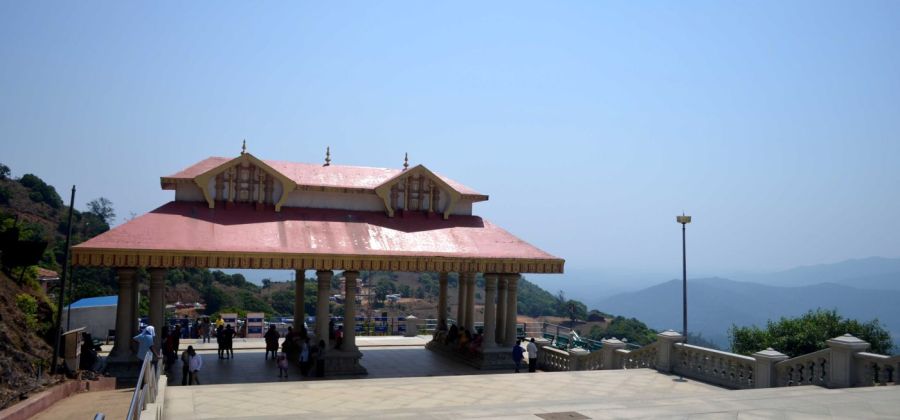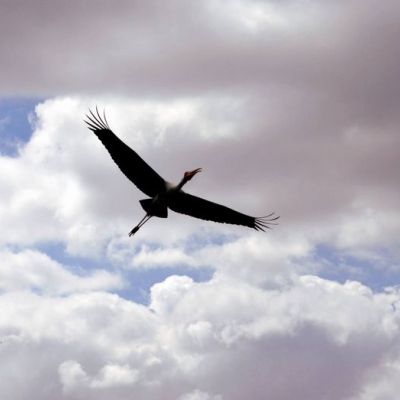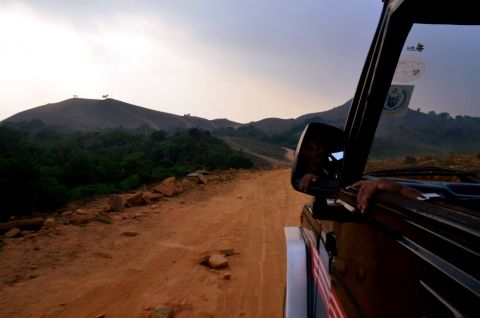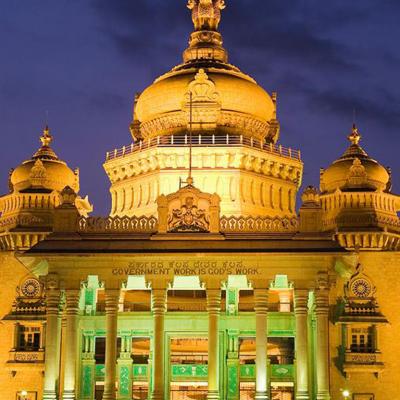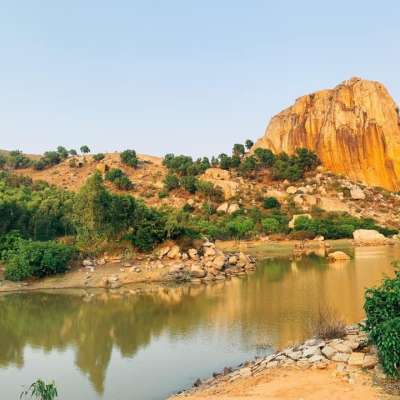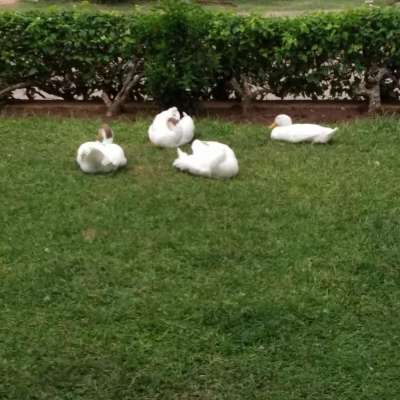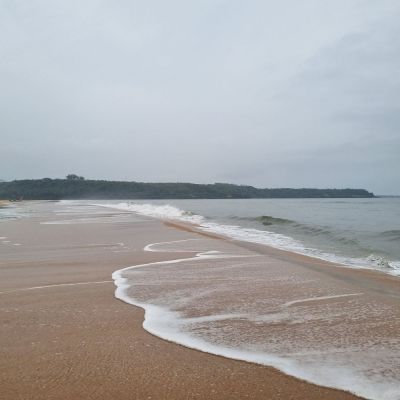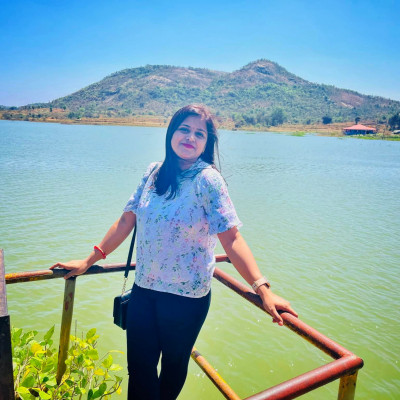A Symphony of Misty Hills and Tranquil Valleys
The first tour we planned after settling down in Bangalore was 'The Scotland of India,' Coorg.
It was the month of March, and the weather was moderate as summer had just begun. Although the recommended time to visit Coorg is during summer (October to April), I prefer exploring hill stations just before the onset of winter. Anyway, this time, we needed a short, relaxing vacation after the hassles of shifting to Bangalore. We hired a car for 2 nights and 3 days from Bangalore and booked a hotel near one of the tourist attractions of Coorg, Madikeri Fort, situated in the center of Madikeri town.
We began our journey in the morning. It's approximately a 5-hour drive from Bangalore. We enjoyed a decent breakfast at A2B restaurant on Mysore Road, with a view of the Wonderla skywheel from the parking area. As we approached Coorg, about 1.5 hours away according to Google Maps, we couldn't see any hills. My travel companions started teasing me about the trip planning. At that time, we didn't have much knowledge about hill stations in the southern part of India, except for Ooty and Kodaikanal.
It's always wise not to react to teasing, as time will speak on your behalf. The overwhelming response from my companions came when we started ascending the hill to reach our hotel in Madikeri town, a small town in the Coorg district. We were stunned by the breathtaking landscapes on one side and green coffee plantations on the other side of the hill. The temperature started to fall, and we witnessed misty clouds around. We reached the hotel around 2 o'clock. After arriving, we realized that our plan to spend a few days amidst nature to shake off the tiredness from the hassles of shifting was successful.
We freshened up and had a late lunch at the hotel. Afterward, we began our Madikeri sightseeing, starting with Madikeri Fort, which is around 2 kilometers from the hotel. It is a 17th-century fort built by Muddu raja, featuring a palace constructed within its walls. The fort is notable for being one of those rebuilt by Tipu Sultan during his 18th-century reign, with the palace reconstructed using granite. Dodda Vira Rajendra, hailed as a hero of Coorg, assumed control of the kingdom from Tipu Sultan in the late 18th century. He is among the kings whose assistance allowed the British to commemorate the death of Tipu Sultan.
The main structures of the fort include the palace, which currently serves as the Madikeri Deputy Commissioner's Office, and St. Mark's Church, originally built by East India Company officers. Post-independence, the Karnataka government took over the church, transforming it into a museum showcasing antiques and weaponry from the fort's inception to the British rule. The museum is currently maintained by the State Archaeological Department. Other notable structures within the fort complex are the Mahatma Gandhi Public Library, the district prison, and a Ganapathi temple.
There is no entry fee for the fort. We entered and strolled along the fort's wall, enjoying the fading afternoon. The scenic view of the surrounding hills from the fort was captivating. The fort's operating hours are from 10 am to 5:30 pm, and it is closed on Mondays.
Next, we headed towards Raja's Tomb, approximately 2 kilometers from the fort. This 19th-century tomb of Hindu rulers was constructed atop a hill. An intriguing aspect of the tomb is that it is the only one where Lord Shiva is worshipped inside, given that the ruler belonged to the Hindu religion. Three tombs were built for the king and the royal family of the Coorg dynasty in the 19th century.
The central tomb is the largest, constructed for the king of Coorg, Dodda Vira Rajendra, by his brother Linga Rajendra II. He and his wife, Mahadeviamma, rest in this tomb. The tomb to the right of the central one belongs to Linga Rajendra II and his wife, built by his son Chikka Veerarajendra, the last king of the Coorg kingdom. The left tomb was erected for Dodda Vira Rajendra's guru, Rudrappa, the royal priest.
We reached the site after sunset. The monument on the hilltop is surrounded by an exquisite garden. We spent some time there in the charming weather of a misty summer evening. Sitting on the uncrowded hilltop, surrounded by the stunning scenery of Coorg and the distant hills, was something worth remembering. Raja's Tomb remains open from 8:30 am to 6 pm.
The next and last destination of our first-day tour in Coorg was Raja's Seat. The name itself reveals that the Raja used to visit this place to enjoy the mesmerizing view of the surrounding hills of Coorg. The place, inside a beautiful park, is open from 9 am to 8 pm. Since we visited in the evening, we missed the view of the setting sun behind the surrounding green hills. There is a children's amusement park, a toy train ride, and a musical fountain. However, I felt the best way to enjoy Raja's Seat is to follow what the Raja used to do— watching beautiful valleys in the mist-covered mountains and spending beautiful moments in the soothing environment.
We returned to the hotel and planned for the next day's trip. The first place to visit on the second day was Talakaveri, which is around a one-and-a-half-hour journey from the hotel. The other two spots to visit on the second day, after lunch, were Abbey Falls and Mandalpatti Falls.
The second day started with a good complimentary breakfast at the open dining hall with a view of the forest behind the hotel. We then began our journey towards Talakaveri, believed to be the source of the Kaveri. It is situated in the dense forest of Brahmagiri hills, 1276 meters above sea level in the Western Ghats. The road to Talakaveri, winding through coffee plantations and forests, with occasional glimpses of the breathtaking Western Ghats ranges, was extremely captivating.
We were captivated by the utterly scenic view of the Western Ghats landscape from the parking area of Talakaveri. Upon entering the Talakaveri temple, I noticed a small spring called Brahma Kund, believed to be the source of the Kaveri River. Although there is no direct flow of water from this place to the Kaveri River, it is believed that water flows underground and surfaces after a short distance. A sacred site, it attracts crowds of tourists from the Hindu religion. There is a large tank near the kund where pilgrims were taking baths before offering prayer. The place has two temples, an ancient Lord Shiva temple, and a Lord Ganesha temple. The temple is open from 6 am to 8:30 pm.
We then returned to Madikeri. On the roadside, we came across some shops selling spices, squash made with local fruits, and coffee. Intrigued, we bought some spices and spent some time in the shop. Behind the shop, the owners had their house. We engaged in a conversation with them, learning more about their life in a village in the mountain area. For lunch, we opted for a restaurant near Madikeri fort. Later, we hired a jeep from our hotel to visit Abbey Falls and Mandalpatti, as private cars are not allowed in Mandalpatti.
We headed towards Abbey Falls, approximately an 8.5-kilometer journey from our hotel. Upon reaching the parking area, we entered the falls area with an entry fee of 15/- per person. We walked towards the falls through a coffee and spice estate, reaching near the falls to find a lesser amount of water flowing. This waterfall is a combination of many small streams that cascade into a pool before merging into the Kaveri River. What I enjoyed the most was the walkway towards the falls, passing through a coffee plantation amidst the soothing cool air. The timing of Abbey Falls is from 9 am to 5 pm.
Our next destination was Mandalpatti, approximately 18 kilometers from Abbey Falls. However, it took almost 1 hour to reach the peak of Mandalpatti due to the rough and risky road conditions. Still, I would say it is a must-visit place in Coorg. Situated in the Pushpagiri reserve forest, the breathtaking views of the lush green Western Ghats as they unveil from mist, and the sensation of reaching the end of the world when all the surrounding ranges and valleys were covered in mist, was simply mesmerizing. We observed two birds gliding in nature's paradise. An air pocket formed between two hills, and these birds were carried away by the air in that small pocket. The birds were reveling in the lap of nature, and we enjoyed witnessing the interaction between living beings and nature for quite a good amount of time.
The timing of Mandalpatti is from 6 am to 6 pm. We reluctantly left the place as it was nearing 6 pm, needing to navigate the rough unpaved road safely before dusk.
Back in Madikeri town, we enjoyed evening tea. Later, we visited the Madikeri market to purchase coffee and also bought some gifts from Kaveri Emporium. I had a plan to taste authentic Coorg food, so we concluded the day with a Coorg special cuisine for dinner. The unique flavors and aromas in the homegrown spices define Kodava/Coorg cuisine. For dinner, we had Akki Roti with Kodava Kottu Curry (Mixed Vegetable Stew) prepared in one clay pot and served hot in the same pot.
After having breakfast, we checked out from the hotel on day 3. Descending from Madikeri hills, we reached our first destination, Chiklihole Reservoir. Nestled inside a forest, it is a secluded place with captivating scenic beauty, featuring lush green forests and distant mountain views. During our visit, there was very little water. We walked around the reservoir and enjoyed the uncrowded, peaceful environment. The reservoir is open from 10 am to 4 pm.
We then proceeded to Dubare Elephant Camp, situated on the bank of the Kaveri River. Initially a training ground for elephants participating in the Mysore Dussehra festival, it now serves as a facility where elephants are trained and utilized for jungle safaris. The camp offers various activities such as elephant rides, elephant interactions and feeding, crossing the Kaveri River on foot, and still-water rafting. Due to the summer season, we were able to cross the river on foot, providing an amusing experience. However, caution needs to be taken due to the slippery river rocks. Unfortunately, the rafting activity was closed due to the low water levels in the river.
The camp operates from 9 am to 11 am and 4:30 pm to 5:30 pm, with an entry fee of 20/- per person. The day activity, including lunch and tea, costs 1310/-, while the elephant activity alone is priced at 670/- per person.
After spending some time at the Kaveri River, we headed to Kushalnagar to visit the Namdroling Monastery Golden Temple. This Tibetan monastery is home to thousands of lamas and includes a junior high school, college, and a hospital for monks.
Upon entering, we encountered a four-story tower with a wheel symbolizing Buddhism at the monastery's entrance. The lanes on either side, after the entrance, were surrounded by neat and clean lawns. The tranquility inside the monastery felt like stepping into a different world. Inside the prayer hall, there are three gold-plated statues: Lord Buddha at the center, and saints Padmasambhava and Amitayus on either side. The walls in the prayer hall are adorned with vibrant Tibetan paintings, and small desks and cylindrical prayer drums are placed inside. Visitors can engage in prayer, rotate the prayer drums, and meditate in the prayer hall.
After a pleasant time at the monastery, we began our journey towards Bangalore. Unfortunately, due to time constraints, we couldn't visit Nagarhole National Park. However, it is highly recommended to include this national park in Coorg's itinerary, as it is one of the top-rated national parks in Karnataka.
Coorg's charm lies not in towering mountains and snow-capped peaks but unfolds in the embrace of abundant greenery. It is found in the quaint beauty of small villages, scattered houses adorned with gardens, and the everyday scenes of boys walking to school on hilly, paved roads. The evenings unfold with the delightful sight of youngsters playing football in the valleys, creating a soothing ambiance unique to this small, picturesque hill station. If anyone is interested in experiencing the verdant beauty of the Western Ghats and soaking in the vibes of a charming hill station, Coorg stands out as the most desirable destination. As we drive away from Coorg, the enchanting beauty of the place leaves an indelible imprint on our travel memories.


